Electrolux Professional AOS062GCP2, AOS201GAP1 Owner’s Manual
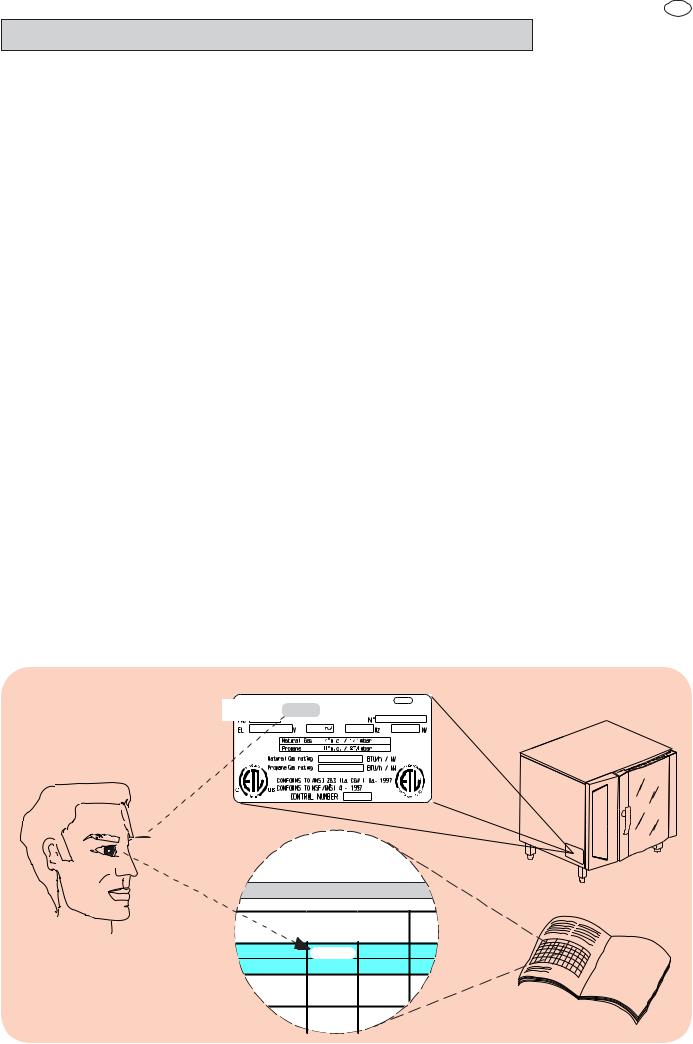
5938 036 01
USA
GAS COMBI - CONVECT OVENS
INSTRUCTIONS FOR INSTALLATION AND USE |
|
|
|
|||||
Table of contents |
Page |
|
|
|
|
|||
- Installation diagram .......................................................... |
2 |
7. |
Safety devices ............................................................. |
18 |
||||
- Appliance identification .................................................... |
9 |
8. |
Operation check .......................................................... |
18 |
||||
I. MAIN FEATURES |
10 |
9. |
Servicing ....................................................................... |
18 |
||||
10.Troubleshooting ........................................................... |
18 |
|||||||
1. |
Description of appliance ............................................. |
10 |
11. Layout of main components ...................................... |
18 |
||||
2. |
Table 1: Technical data ................................................. |
11 |
III. INSTRUCTIONS FOR USE |
19 |
||||
3. |
Precautions |
12 |
||||||
|
|
|
|
|||||
4. |
Safeguarding the environment ................................... |
13 |
1. |
Opening the oven door ................................................ |
19 |
|||
|
4.1 |
Packaging .............................................................. |
13 |
|
1.1 |
6- and 10-grid models ........................................... |
19 |
|
|
4.2 |
Use ......................................................................... |
13 |
|
1.2 |
20-GRID models .................................................... |
19 |
|
|
4.3 |
Cleaning ................................................................ |
13 |
2. |
Closing the oven door ................................................. |
19 |
||
|
4.4 |
Disposal ................................................................. |
13 |
|
2.1 |
6- and 10-GRID models ......................................... |
19 |
|
II. INSTRUCTIONS FOR INSTALLATION |
14 |
|
2.2 |
20-GRID models .................................................... |
19 |
|||
3. |
Description of the control panel ................................. |
20 |
||||||
1. |
Place of Installation ..................................................... |
14 |
|
3.1 |
Introduction ............................................................ |
20 |
||
|
1.1 |
Ventilation ................................................................ |
14 |
|
3.2 |
Main controls ......................................................... |
20 |
|
|
1.2 |
Reference standards ............................................... |
14 |
|
3.3 |
Main cooking modes ............................................. |
20 |
|
|
1.3 |
Unpackaging ........................................................... |
14 |
|
3.4 |
Special cooking modes ......................................... |
20 |
|
|
1.4 |
Immediately inspect for shipping damage .............. |
14 |
|
3.5 |
Additional functions ............................................... |
21 |
|
2. |
Positioning..................................................................... |
14 |
USING THE OVEN |
22 |
||||
3. |
Combusted gas discharge |
14 |
||||||
|
|
|
|
|||||
|
3.1 |
Foreword .................................................................. |
14 |
4. |
Introduction .................................................................. |
22 |
||
|
3.2 Installation of accessories ................................ |
15 |
|
4.1 |
Switching the oven on ........................................... |
22 |
||
|
3.3 |
Warnings regarding the fluimg system .................. |
15 |
|
4.2 |
Selecting the controls ............................................ |
22 |
|
4. |
Electrical connection................................................... |
15 |
|
4.3 |
Manual controls ..................................................... |
22 |
||
|
4.1 |
Installing the power supply cable .......................... |
16 |
|
4.4 |
Automatic controls ................................................. |
26 |
|
5. |
Water mains connection ............................................. |
16 |
5. |
Information and error codes ....................................... |
29 |
|||
|
5.1 |
Water supply characteristics .................................. |
16 |
6. |
SWITCHING off in the event of a fault ........................ |
30 |
||
|
5.2 |
Water drain system ................................................ |
16 |
7. |
Care and maintenance ................................................ |
30 |
||
6. |
Gas connection ............................................................ |
17 |
|
7.1 |
Periodical maintenance of the BOILER ................. |
31 |
||
|
6.1 |
Warning .................................................................. |
17 |
|
7.2 |
Replacing CONSUMABLE components ............... |
32 |
|
|
6.2 |
Nominal heat output .............................................. |
17 |
|
7.3 |
Special cleaning instructions ................................. |
32 |
|
|
6.3 |
Checking the supply pressure ............................... |
17 |
- CONTROL PANEL FIGURES |
105 |
|||
|
|
|
|
|||||
- APPLIANCE IDENTIFICATION
Rating plate
PNC 9PDX 260462 05
2. TABLE 1: TECHNICAL DATA
6GN1/1 |
|
|
|
(AOS061E) |
|
|
|
260450-260510 |
62 |
260456 |
26045 |
|
260462 |
|
|
260451-260511 |
260463 |
260457 |
2604 |
° |
° |
° |
|
** |
** |
** |
|
400 |
230 |
200 |
|
3 N~ |
3 ~ |
3 ~ |
|
9

USA
I. MAIN FEATURES
1. DESCRIPTION OF APPLIANCE
This booklet describes a number of appliance models.
For more detailed information about the model in your possession, refer to "Technical Data" table 1.
The appliance has the following features:
•Digital temperature controlle.
•Thermostatic probe for measuring the core temperature of products (core temperature probe).
•Automatic flush to drain every two hour to prevent the build-up of lime-scale in the boiler.
•Periodic draining and automatic washing of the boiler to prevent the build-up of lime-scale (only available on certain models).
•Boiler lime-scale level indicator (see corresponding paragraph).
•Oven chamber automatic fast steam drain device for gratins.
•Air-break (anti-backup drain) device to prevent backflows from the drain system from entering the oven (only available on certain models).
•Halogen lighting in the cooking chamber.
•Double-action door opening safety mechanism designed to protect the user from scalding steam (only available on certain models).
•Double-glazed oven door for reduced heat dispersion into the kitchen and low temperatures on the exterior of the oven.
•Daily oven chamber cleaning cycle (CLEANING SYSTEM).
•Self-diagnostics system indicating oven faults using error codes (see "Information and error codes ").
5938 036 01
10

5938 036 01
|
|
|
|
|
|
|
|
|
|
|
|
|
|
|
USA |
|
|
|
|
|
|
|
|
|
|
|
|
|
|
|
|
|
|
2. TABLE 1: TECHNICAL DATA |
|
|
|
|
|
|
|
|
|
|
|
|||||
|
|
|
|
|
|
|
|
|
|
|
|
|
|
|
|
|
GRIDS |
|
6 GN 1/1 |
6 GN 2/1 |
10 GN 1/1 |
|
10 GN 2/1 |
20 GN 1/1 |
20 GN 2/1 |
|
|||||||
|
|
|
|
|
|
|
|
|
|
|
|
|
|
|
|
|
PNC * |
|
A^ |
267550 |
|
267551 |
|
267552 |
|
|
267553 |
|
267554 |
|
267555 |
|
|
|
C^ |
|
269550 |
|
269551 |
|
269552 |
|
|
269553 |
|
269554 |
|
269555 |
|
|
|
|
|
|
|
|
|
|
|
|
|||||||
CONVECTOR ° |
|
° |
° |
° |
° |
° |
° |
|
° |
° |
° |
° |
° |
° |
|
|
BOILER ** |
|
** |
|
** |
|
** |
|
|
** |
|
** |
|
** |
|
|
|
|
|
|
120V |
120V |
120V |
120V |
120V |
120V |
|
120V |
120V |
120V |
120V |
120V |
120V |
|
SUPPLY VOLTAGE |
1ph |
1ph |
1ph |
1ph |
1ph |
1ph |
|
1ph |
1ph |
1ph |
1ph |
1ph |
1ph |
|
||
60Hz |
60Hz |
60Hz |
60Hz |
60Hz |
60Hz |
|
60Hz |
60Hz |
60Hz |
60Hz |
60Hz |
60Hz |
|
|||
|
|
|
|
|
||||||||||||
|
|
|
10amp |
10amp |
10amp |
10amp |
10amps |
10amps |
|
10amps |
10amps |
10amps |
10amps |
20amps |
20amps |
|
Total W atts |
|
0,45 kW |
0,45 kW |
0,9 kW |
0,9 kW |
0,5 kW |
0,5 kW |
|
1 kW |
1 kW |
0,85 kW |
0,85 kW |
2 kW |
2 kW |
|
|
|
|
|
|
|
|
|
|
|
|
|
|
|
|
|
|
|
Maximum load capacities |
66 lbs. |
66 lbs. |
122 lbs. |
122 lbs. |
110 lbs. |
110 lbs. |
|
220 lbs. |
220 lbs. |
220 lbs. |
220 lbs. |
440 lbs. |
440 lbs. |
|
||
(food) |
|
(30 kg) |
(30 kg) |
(60 kg) |
(60 kg) |
(50 kg) |
(50 kg) |
|
(100 kg) |
(100 kg) |
(100 kg) |
(100 kg) |
(200 kg) |
(200 kg) |
|
|
|
|
|
|
|
|
|
|
|
|
|
|
|
|
|
|
|
Net w eight |
|
254 lbs. |
254 lbs. |
353 lbs. |
353 lbs. |
320 lbs |
320 lbs |
|
505 lbs |
505 lbs |
551 lbs. |
551 lbs. |
1058 lbs |
1058 lbs |
|
|
|
(115 kg) |
(115 kg) |
(160 kg) |
(160 kg) |
(145 kg) |
(145 kg) |
|
(229 kg) |
(229 kg) |
(250 kg) |
(250 kg) |
(480 kg) |
(480 kg) |
|
||
|
|
|
|
|
||||||||||||
|
|
|
287 lbs. |
287 lbs. |
386 lbs. |
386 lbs. |
364 lbs. |
364 lbs. |
|
538 lbs |
538 lbs |
617 lbs. |
617 lbs. |
1080 lbs |
1080 lbs |
|
Shipping w eight |
|
|
|
|||||||||||||
|
(130 kg) |
(130 kg) |
(130 kg) |
(130 kg) |
(165 kg) |
(165 kg) |
|
(244 kg) |
(244 kg) |
(280 kg) |
(280 kg) |
(490 kg) |
(490 kg) |
|
||
|
|
|
|
|
||||||||||||
|
|
|
38 |
38 |
44 |
44 |
38 |
38 |
|
44 |
44 |
38 |
38 |
44 |
44 |
|
Shipping w idth |
|
|
|
|||||||||||||
|
3/4"inch |
3/4"inch |
11/16"inch |
11/16"inch |
3/4"inch |
3/4"inch |
|
11/16"inch |
11/16"inch |
3/4"inch |
3/4"inch |
11/16"inch |
11/16"inch |
|
||
|
|
|
(940 mm) |
(940 mm) |
(1135 mm) |
(1135 mm) |
(985 mm) |
(985 mm) |
|
(1135 mm) |
(1135 mm) |
(985 mm) |
(985 mm) |
(1135 mm) |
(1135 mm) |
|
Shipping height |
|
42 |
42 |
42 |
42 |
52 |
52 |
|
52 |
52 |
81 |
81 |
81 |
81 |
|
|
|
1/8"inch |
1/8"inch |
1/8"inch |
1/8"inch |
3/16"inch |
3/16"inch |
|
3/16"inch |
3/16"inch |
1/8"inch |
1/8"inch |
1/8"inch |
1/8"inch |
|
||
|
|
|
(1040 mm) |
(1040 mm) |
(1040 mm) |
(1040 mm) |
(1325 mm) |
(1325 mm) |
|
(1325 mm) |
(1325 mm) |
(2060 mm) |
(2060 mm) |
(2060 mm) |
(2060 mm) |
|
Shipping depth |
|
37 |
37 |
44 |
44 |
37 |
37 |
|
44 |
44 |
41 |
41 |
51 |
51 |
|
|
|
5/8"inch |
5/8"inch |
13/16"inch |
13/16"inch |
5/8"inch |
5/8"inch |
|
13/16"inch |
13/16"inch |
3/4"inch |
3/4"inch |
3/16"inch |
3/16"inch |
|
||
|
|
|
(980 mm) |
(980 mm) |
(1265 mm) |
(1265 mm) |
(955 mm) |
(955 mm) |
|
(1265 mm) |
(1265 mm) |
(1060 mm) |
(1060 mm) |
(1300 mm) |
(1300 mm) |
|
ISO 7/1 gas |
|
1/2" M |
1/2" M |
1/2" M |
1/2" M |
1/2" M |
1/2" M |
|
1/2" M |
1/2" M |
1" M |
1" M |
1" M |
1" M |
|
|
connectionDiameter |
|
|
||||||||||||||
|
|
|
|
|
|
|
|
|
|
|
|
|
|
|||
|
|
|
|
|
|
|
|
|
|
|
|
|
|
|
|
|
Nominal heat output |
683046 |
40982 |
122946 |
78549 |
136607 |
78549 |
|
177589 |
105871 |
232232 |
160513 |
379085 |
218571 |
|
||
btu/h |
btu/h |
btu/h |
btu/h |
btu/h |
btu/h |
|
btu/h |
btu/h |
btu/h |
btu/h |
btu/h |
btu/h |
|
|||
NATURAL |
|
|
|
|||||||||||||
|
(20 kW) |
(12 kW) |
(36 kW) |
(23 kW) |
(40 kW) |
(23 kW) |
|
(52 kW) |
(31 kW) |
(68 kW) |
(47 kW) |
(111 kW) |
(64 kW) |
|
||
|
|
|
|
|
||||||||||||
Boiler unit nom ina l |
40982 |
|
61473 |
|
78549 |
|
|
102455.4 |
|
102455.4 |
|
218571 |
|
|
||
heat output |
|
btu/h |
_ |
btu/h |
_ |
btu/h |
_ |
|
btu/h |
_ |
btu/h |
_ |
btu/h |
_ |
|
|
NATURAL |
|
(12 kW) |
|
(18 kW) |
|
(23 kW) |
|
|
(30 kW) |
|
(30 kW) |
|
(64 kW) |
|
|
|
Convector unit nominal |
40982 |
40982 |
78549 |
78549 |
78549 |
78549 |
|
105871 |
105871 |
160513.4 |
160513 |
218571 |
218571 |
|
||
heat output |
|
btu/h |
btu/h |
btu/h |
btu/h |
btu/h |
btu/h |
|
btu/h |
btu/h |
btu/h |
btu/h |
btu/h |
btu/h |
|
|
NATURAL |
|
(12 kW) |
(12 kW) |
(23 kW) |
(23 kW) |
(23 kW) |
(23 kW) |
|
(31 kW) |
(31 kW) |
(47 kW) |
(47 kW) |
(64 kW) |
(64 kW) |
|
|
Nominal heat output |
61473 |
35859 |
110993 |
71719 |
126362 |
71719 |
|
160513.4 |
95625.0 |
208326 |
143438 |
334688 |
191250.0 |
|
||
btu/h |
btu/h |
btu/h |
btu/h |
btu/h |
btu/h |
|
btu/h |
btu/h |
btu/h |
btu/h |
btu/h |
btu/h |
|
|||
PROPANE |
|
|
|
|||||||||||||
|
(18 kW) |
(10.5 kW) |
(32.5 kW) |
(21 kW) |
(37 kW) |
(21 kW) |
|
(47 kW) |
(28 kW) |
(61 kW) |
(42 kW) |
(98 kW) |
(56 kW) |
|
||
|
|
|
|
|
||||||||||||
Boiler unit nom ina l |
35859.4 |
|
54643 |
|
71719 |
|
|
88795 |
|
88795 |
|
191250 |
|
|
||
heat output |
|
btu/h |
_ |
btu/h |
_ |
btu/h |
_ |
|
btu/h |
_ |
btu/h |
_ |
btu/h |
_ |
|
|
PROPANE |
|
(10.5 kW) |
|
(16 kW) |
|
(21 kW) |
|
|
(26 kW) |
|
(26 kW) |
|
(56 kW) |
|
|
|
Convector unit nominal |
35859 |
35859 |
71719 |
71719 |
71719 |
71719 |
|
95625.0 |
95625.0 |
143438 |
143438 |
191250 |
191250 |
|
||
heat output |
|
btu/h |
btu/h |
btu/h |
btu/h |
btu/h |
btu/h |
|
btu/h |
btu/h |
btu/h |
btu/h |
btu/h |
btu/h |
|
|
PROPANE |
|
(10.5 kW) |
(10.5 kW) |
(21 kW) |
(21 kW) |
(21 kW) |
(21 kW) |
|
(28 kW) |
(28 kW) |
(42 kW) |
(42 kW) |
(56 kW) |
(56 kW) |
|
|
Gas type |
|
NATURAL |
NATURAL |
NATURAL |
NATURAL |
NATURAL |
NATURAL |
|
NATURAL |
NATURAL |
NATURAL |
NATURAL |
NATURAL |
NATURAL |
|
|
|
PROPANE |
PROPANE |
PROPANE |
PROPANE |
PROPANE |
PROPANE |
|
PROPANE |
PROPANE |
PROPANE |
PROPANE |
PROPANE |
PROPANE |
|
||
|
|
|
|
|
||||||||||||
|
|
|
|
|
|
|
|
|
|
|
|
|
|
|
|
|
Construction type |
A3 |
A3 |
A3 |
A3 |
A3 |
A3 |
|
A3 |
A3 |
A3 |
A3 |
A3 |
A3 |
|
||
B13 |
B13 |
B13 |
B13 |
B13 |
B13 |
|
B13 |
B13 |
B13 |
B13 |
B13 |
B13 |
|
|||
|
|
|
|
|
||||||||||||
Diagram of fumes |
1a-1b-1c |
1a-1b-1c |
1a-1b-1c |
|
1a-1b-1c |
1a-1b-1c |
1a-1b-1c |
|
||||||||
discharge system |
|
|
||||||||||||||
|
|
|
|
|
|
|
|
|
|
|
|
|
|
|||
NATURAL pressure |
7"w c |
7"w c |
7"w c |
7"w c |
7"w c |
7"w c |
|
7"w c |
7"w c |
7"w c |
7"w c |
7"w c |
7"w c |
|
||
(17,4mbar) |
(17,4mbar) |
(17,4mbar) |
(17,4mbar) |
(17,4mbar) |
(17,4mbar) |
|
(17,4mbar) |
(17,4mbar) |
(17,4mbar) |
(17,4mbar) |
(17,4mbar) |
(17,4mbar) |
|
|||
|
|
|
|
|
||||||||||||
|
|
|
|
|
|
|
|
|
|
|
|
|
|
|
|
|
PROPANE pressure |
11"w c |
11"w c |
11"w c |
11"w c |
11"w c |
11"w c |
|
11"w c |
11"w c |
11"w c |
11"w c |
11"w c |
11"w c |
|
||
(27,4mbar) |
(27,4mbar) |
(27,4mbar) |
(27,4mbar) |
(27,4mbar) |
(27,4mbar) |
|
(27,4mbar) |
(27,4mbar) |
(27,4mbar) |
(27,4mbar) |
(27,4mbar) |
(27,4mbar) |
|
|||
|
|
|
|
|
||||||||||||
|
|
|
|
|
|
|
|
|
|
|
|
|
|
|
|
|
|
|
|
|
|
|
|
|
|
|
|
|
|
|
|
|
|
Noise emission data: Noise emissions generated by the appliances described in this booklet do not exceed 70 dB (A).
* Your appliance model is indicated in the box marked PNC on the Identification dataplate affixed to the bottom left hand side of the oven.
^ FUNCTIONAL LEVEL. (C = Convect, Convection)
11
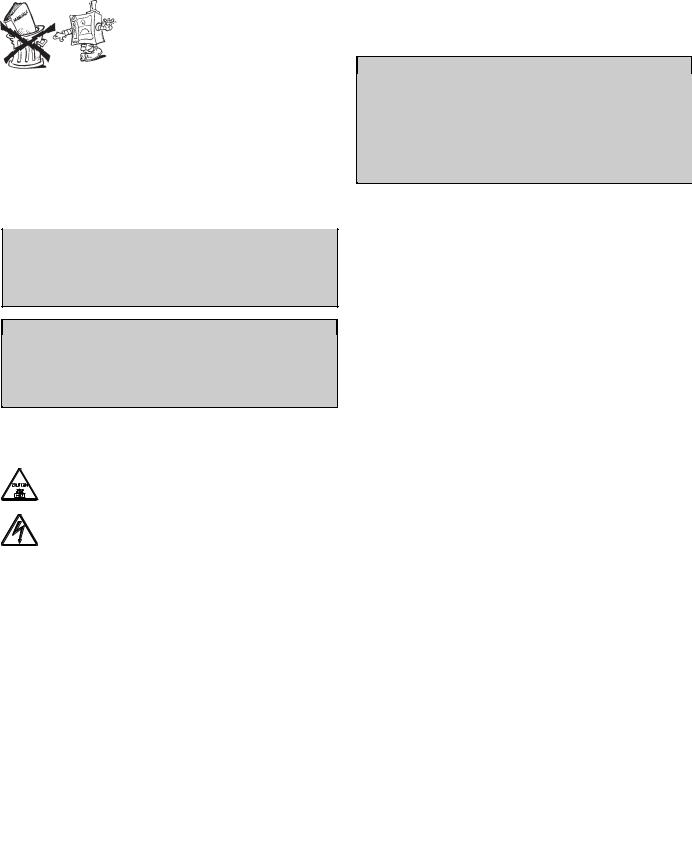
USA
3. PRECAUTIONS
•The following terms alert you to potentially dangerous conditions to the operator, service personnel or to the equipment.
•Danger! This term warns of immediate hazards which will result in severe injury or death.
•Warning! This term refers to a potential hazard or unsafe practice which could result in injury or death.
•Notice. This term refers to information that needs special attention or must be fully understood, even though not dangerous.
•Keep the appliance area free and clear from combustibles.
Warning Fire hazard.
For your safety, do not store or use gasoline or other flammable, vapors and liquids in the vicinity of this or any other appliance.
Keep area around appliances free and clear of combustibles
Warning!
Failure to properly vent the oven can be hazardous to the
health of the operator; and will result in operational problems,
unsatisfactory baking, and possible damage to the equipment.
Damage sustained as a direct result of improper ventilation will
not be covered by the Manufacturer's warranty.
NOTICE: INTENDED FOR COMMERCIAL USE ONLY. NOT FOR HOUSEHOLD USE.
CAUTION HOT SURFACES
CAUTION RISK ELECTRIC SHOCK
CAUTION: Do not locate unit adjacent to any high heat or grease producing piece of equipment, such as a range top, griddle, fryer, etc., that could allow radiant heat to raise the exterior temperature of the Oven.
• Carefully read this instruction booklet, as it contains important advice for safe installation, operation and maintenance.
•Keep this instruction booklet in a safe place for future reference.
•The installation of this unit must conform to local codes or, in the absence of local codes, to all National Codes governing plumbing, sanitation, safety and good trade practices.
WARNING: The equipment warranty is not valid unless the appliance is installed, started and demonstrated under the supervision of a factory trained installer.
WARNING: The unit must be installed by Personnel who are qualified to work with electricity and plumbing. Improper installation can cause injury to personnel and/or damage to the equipment. The unit must be installed in accordance with applicable codes.
Important: The installation instructions contained herein are for the use of qualified installation and service
personnel only. Installation or service by other than
qualified personnel may result in damage to the appliance
and/or injury to the operator. FAILURE TO COMPLY
WITH INSTALLATION INSTRUCTION OR IMPROPER INSTALLATION WILL VOID WARRANTY AND RESPONSIBLITIES OF THE MANUFACTURE.
•Our appliances have been studied and optimized to give the highest performance. This appliance is intended for industrial use only and is specifically designed to cook food. Any other use will be considered “improper use” and will void the warranty and manufacturer liability.
•This appliance is not intended for use by people (including
children) with limited physical, sensory or mental abilities or without experience and knowledge of it, unless they are supervised or instructed in its use by a person responsible for their safety.
WARNING: ANY POTENTIAL USER OF THE EQUIPMENT SHOULD BE TRAINED IN SAFE AND CORRECT OPERATIONG PROCEDURES.
WARNING: BEFORE SERVICING, DISCONNET THE ELECTRICAL SERVICE AND PLACE A RED TAG AT THE DISCONNECTSWITCHTOINDICATEDWORKISBEINGDONE ON THAT CIRCUIT.
NOTICE: Using any parts other than OEM original spare parts relieves the manufacturer of all warranty and liability.
NOTICE: Manufacturer reserves the right to change specifications at any time without notice.
Failure to comply with the above requirement may jeopardise the safety of the appliance and invalidate the guarantee. WARNING: DO NOT SPRAY THE OUTSIDE OF THE APPLIANCE WITH WATER OR CLEAN WITH A WATER JET. CLEANING WITH A WATER JET CAN IMPREGNAT CHLORIDES INTO THE STAINLESS STEEL, CAUSING THE ONSET OF CORROSION.
WARNING: DO NOT USE PRODUCTS CONTAINING CHLORINE (BLEACH, HYDROCHLORIC ACID ETC.) EVEN DILUTED, TO CLEAN STEEL SURFACES.
WARNING: DO NOT USE CORROSIVE SUBSTANCES (E.G. MURIATIC ACID) TO CLEAN THE FLOOR UNDER THE APPLIANCE.
5938 036 01
12

USA
4. SAFEGUARDING THE ENVIRONMENT
4.1 PACKAGING
• All the packaging materials used are environmentally safe and friendly. They may be stored without fear or danger. They may be recycled or burned in a special waste incineration plant. Recyclable plastic components are marked as follows:
polyethylene : external wrapping film, instructions
PE |
booklet bag and gas injectors bag |
polypropylene: top packaging panels and straps
pp
expanded polystyrene: protective surround elements
PS
4.2 USE
• The appliance has been designed and perfected under laboratory testing conditions to offer exceptional levels of performance. However, to minimise energy consumption (electricity, gas and water), do not leave the appliance in operation for long periods without food in the oven chamber and avoid conditions that reduce efficiency (e.g. door open). We also recommend preheating the appliance immediately prior to use.
4.3 CLEANING
• To minimise the emission of pollutants into the environment, clean the appliance (externally and, where necessary, internally) with products that are at least 90% biodegradable.
4.4 DISPOSAL
•Appliances that have reached the end of their service life should be suitably disposed of.
•The appliance is made from more than 90% recyclable materials (stainless steel, iron, aluminium, galvanised sheet steel, etc.). These materials may therefore be scrapped in accordance with local waste disposal regulations at a conventional recycling plant.
•Make the appliance unusable by cutting off the power cord. Also remove any compartment or interior closure device fitted on the appliance to prevent persons from becoming trapped inside.
5938 036 01
13
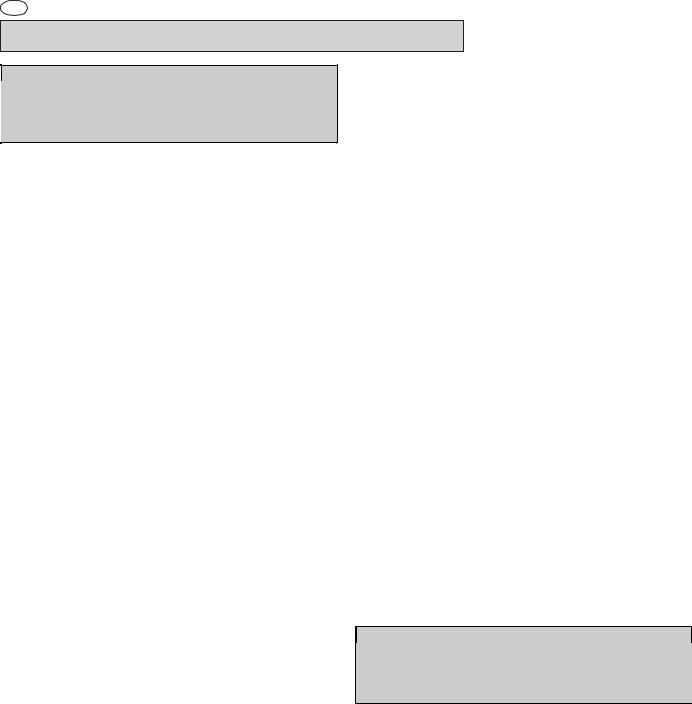
USA
II. INSTRUCTIONS FOR INSTALLATION
Important: The oven outer panels must be removed to
perform the operations described in this chapter. Since the
appliance must be switched on to make certain
adjustments, exercise the utmost care when working in the
vicinity of live electrical parts.
1. PLACE OF INSTALLATION
1.1 VENTILATION
The necessity for a properly designed and installed ventilation system cannot be over emphasized. The ventilation system will allow the unit to function properly while removing unwanted vapors and products of combustion from the operating area.
Theappliancemustbeventedwithaproperlydesignedmechanically driven exhaust hood. The hood should be sized to completely cover the equipment plus an overhang of a least 6"/15.3cm on all sides not adjacent to a wall. The capacity of the should be sized appropriately and provisions for adequate makeup air.
Refer to your local ventilation codes. In the absence of local codes, refer to the National ventilation code titled, “Standard for the Installation of Equipment for the Removal of Smoke and Grease Laden Vapors from Commercial Cooking Equipment”, NFPA-96- Latest Edition.
It is recommended that the ventilation system and duct work be checkedatprevailingintervalsasspecifiedbythehoodmanufactured
• Theappliancemustonlybeinstalledinadequatelyventilated premises.
NOTICE: Proper ventilation is the owner's is responsibility. Any problem due to improper ventilation will not be covered by the warranty.
1.2 REFERENCE STANDARDS
Note: The electric supply installation must satisfy the requirements of the appropriate statutory authority, such as the National Electrical Code (NEC) ANSI/NFPA70, (U.S.A..): the Canadian Electrical Code, CSA C22.2; or other applicable regulations.
Note: The electric supply connection must meet all national and local electrical code requirements.
Note: The installation of this unit must conform to local codes or, in the absence of local codes, to all National Codes governing plumbing, sanitation, safety and good trade practices, and to the National Gas Code ANSI Z223.1.
• Local codes regarding installation vary greatle from one area to another. This equipment is to be installed to comply with the applicable federal, state or local codes.
The installation instructions contained herein are for the use of qualified installation and service personnel only. Installation or service by other than qualified personnel may result in damage to the appliance and/or injury to the operator.
FAILURE TO COMPLY WITH INSTALLATION INSTRUCTION OR IMPROPER INSTALLATION WILL VOID WARRANTY AND RESPONSIBLITIES OF THE MANUFACTURE.
The National Fire Protection Association, Inc states in its NFPA 96 latest edition that local codes are the "authority having jurisdiction" when it comes to installation requirements for equipment. Therefore, installations should comply with all local codes.
1.3 UNPACKAGING
•Remove the appliance from the packaging and take away the protective film that covers the appliance's external panels carefully to avoid leaving any trace of glue. If necessary remove the glue using an a non-corrosive solvent, rinsing it off and drying carefully.
•Dispose of packaging material in compliance with the regulations in force in the country where the product is to be used.
1.4 IMMEDIATELY INSPECT FOR SHIPPING DAMAGE
The container should be examined for damage before and during unloading. The freight carrier has assumed responsibility for its safe transit and delivery. If damaged equipment is received, either apparent or concealed, a claim must be made with the delivering carrier. Apparent damage or loss must be noted on the freight bill at the time of delivery. The freight bill must then be signed by the carrier representative (Driver). If the bill is not signed, the carrier may refuse the claim. The supply can supply the necessary forms. A request for inspection must be made to the carrier within 15 days if there is concealed damage or loss that is not apparent until after the equipment is uncrated. The carrier should arrange an inspection. Be certain to hold all contents plus all packing material. Under no circumstances should a damaged appliance be returned to the manufacturer without prior notice and written authorization.
2. POSITIONING
•Refer to the installation diagrams at the beginning of this booklet for the space requirements and connection dimensions of the appliance.
•Clearance of approximately 23.62" (50cm) must be left between the appliance’s left side panel and adjacent structures in order to provide space for maintenance operations when needed; the right side panel and the rear panel of the appliance must be at least 3.94" (10cm) from adjacent structures.
•Place the appliance in the required position and level the oven with a slight pitch toward the rear to help drain water from chamber using the appropriate bullet feet.
•The appliance is not suitable for built-in installation.
Warning: The oven must be installed on an even (level) nonflammable flooring and any adjacent walls must be non-flammable. Recommended minimum clearance are specified in this manaul.
Important:
Make sure steam from the oven’s drain or adjacent
appliances does not enter the aeration vents under the
appliance, designed to cool internal components
located at the bottom of the appliance.
3. COMBUSTED GAS DISCHARGE
3.1FOREWORD
In relation to the combustion technology utilised, gas fired steam/ convection ovens are classified in accordance with their "Construction Type". For each of these types of appliances applicable regulations stipulate a specific type of combusted gas discharge system.
Consequently, before installing the discharge system:
a)identify the "Construction type" of your model in Table 1 (technical data) or by checking the appliance identification dataplate;
b)choose the diagram with the type of construction among those shown as follows (fig. 1a-1b-1c), depending on how you
intend to exhaust the appliance fumes from the place of installation (e.g. discharge under extraction hood, direct to the outside, or in a central flue).
5938 036 01
14
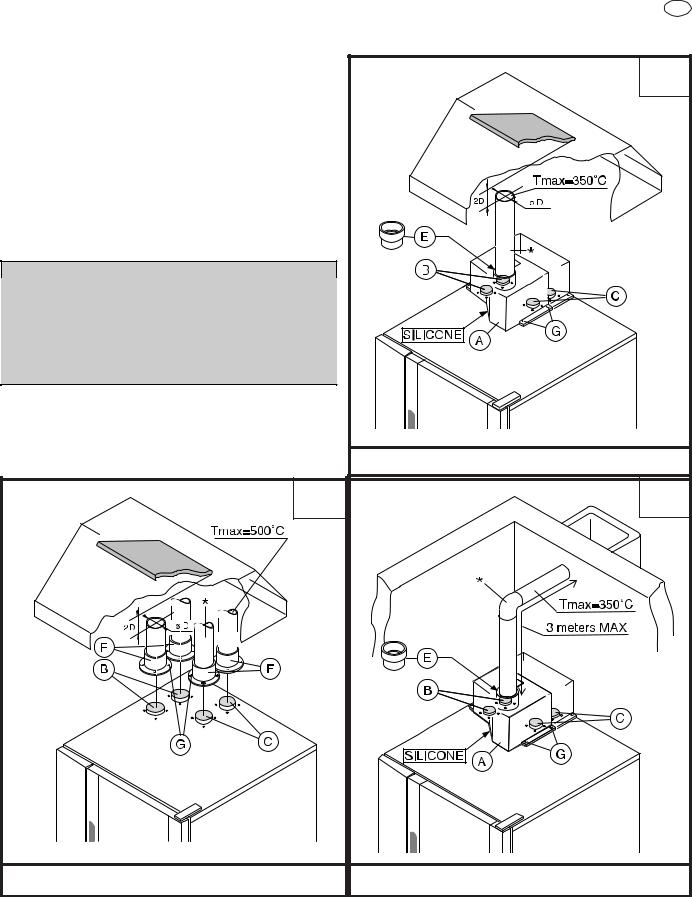
|
|
|
USA |
|
3.2 WARNINGS REGARDING THE FLUING SYSTEM |
CONSTRUCTION TYPE |
1b |
||
Before installation check, on the basis of the contents of the |
||||
B13 |
||||
reference standard, to ensure that the volume aspirated by the |
||||
fumes exhausting system is greater than the volume of combusted |
|
|
||
gas produced by the appliance (see point 1.1). |
|
|
|
|
If the solution of combusted gas discharge under an extractor |
|
|
||
hood is chosen, observe the distance (shown in the figure) |
|
|
||
between the top of the discharge pipe and the lowest point of the |
|
|
||
hood filters. This distance is defined on the basis of discharge |
|
|
||
pipe diameter "D". |
|
|
|
|
In the case of discharge direction to the outside or into a central |
|
|
||
flue (Fig. "1c"), the discharge ducts must NOT present an overall |
|
|
||
length in excess of 762"(3 metres), must NOT have any reductions |
|
|
||
in diameter, and must be subjected to periodic inspection and, |
|
|
||
when necessary, cleaning. |
|
|
|
|
Warning: Since combusted gas (see figure) can reach very |
|
|
||
high temperatures, check the heat resistant properties of |
|
|
||
extension ducts if fitted and the filters in the extractor hood |
|
|
||
to ensure the materials are compatible with the temperature |
|
|
||
conditions. In addition, periodically check the condition of |
|
|
||
the filters which, if excessively fouled with fat and dirt, will |
|
|
||
reduce the efficiency of the suction system and may catch |
|
|
||
fire. |
|
|
|
|
3.3 INSTALLATION OF ACCESSORIES |
|
|
|
|
Accessories can be easily installed by following the figures below |
|
|
||
together with the relative key. |
|
|
|
|
The screw holes for fixing accessories "A" and "F" are 0.14"(3.5 |
|
|
||
mm) in diameter and they must be drilled in-situ on the oven cover |
DISCHARGE WITH SHROUD UNDER EXTRACTOR HOOD |
|||
in correspondence with the punch marks. |
|
|||
|
|
|
||
CONSTRUCTION TYPE |
1a |
CONSTRUCTION TYPE |
1c |
|
A3 |
B13 |
|||
DIRECT UNDUCTED DISCHARGE UNDER EXTRACTOR HOOD |
DISCHARGE TO THE OUTSIDE OR CENTRAL FLUE WITH SHROUD |
|||
|
LEGENDA: |
F: |
Conical connections for single outlet (supplied) |
|||
|
A: |
Cam / draught damper accessory |
||||
|
|
(to be ordered from manufacturer) |
G: |
(always install) |
||
|
B: |
Boiler combusted gas discharge |
Fixing screws (supplied); |
|||
01 |
C: |
Oven chamber convector combusted gas discharge |
*: |
Commercial extension pipes (not supplied) |
||
E: |
Adapter ring for commercial ducts |
|
|
|
: |
|
036 |
|
SILICONE |
||||
|
(to be ordered from manufacturer) |
|
|
Apply silicone sealant between contact surfaces |
||
5938 |
|
|
|
|||
|
|
|
|
|
|
|
15
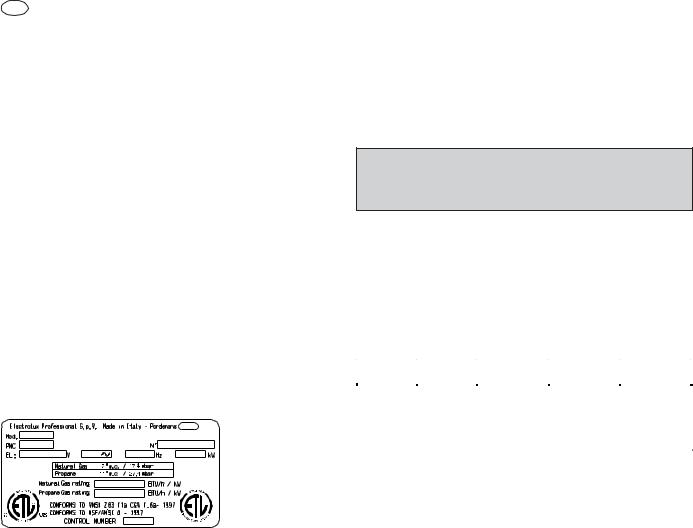
USA
4. ELECTRICAL CONNECTION
•A fused disconnect switch or main circuit breaker (customer furnished) MUST be installed in the electric supply line for the appliance. It is recommended that this switch/circuit breaker have lockout/tagout capability. Before making any electrical connections to this appliance, check that the power supply is adequate for the voltage, amperage, and phase requirements on the rating plate.
•A safety cutout switch of suitable capacity with a contact breaking distance of at least 3 mm must be fitted upstream of the appliance.
The cutout switch must be installed near the appliance in the permanent electrical system of the premises.
•The appliance must be electrically grounded in accordance with local codes, or in the absence of local codes, with the National Electrical Code, ANSI/NFPA 70, or the Canadian Electrical Code, CSA C22.2, as applicable.
The grounding conductor must therefore be connected to the terminal marked Gon the connection terminal board. The appliance must also be connected to an earth grounding system.
This connection is made using the stop screw marked E located on the outside of the appliance near the power cable inlet.
The grounding wire must have a minimum cross-section of 8 AWG (10 mm2).
RATING PLATE
4.1 INSTALLING THE POWER SUPPLY CABLE
To access the power supply cable connection terminal board, proceed as follows:
Model 6 - 10 - 20 GN
•Remove the left side panel.
•Connect the power supply cable to the terminal board according to the instructions given in the wiring diagram and fasten the power supply cable by means of strain-relief fitting (not furnished with the oven).
Failure to comply with safety rules and regulations relieves the manufacturer of all liability.
The manufacturer requires when stacking units each appliance have its own branch circuit protection. An oven unit stacked with an blast chiller unit should have a separate protection for the upper and lower units.
5. WATER MAINS CONNECTION
(Refer to the installation diagrams at the beginning of this booklet).
This equipment is to be installed to comply with the applicable Federal, State, Local plumbing codes, or the Basic Plumbing Code of the Building Officials and Code Administrators International Inc. (BOCA) and Food Service Sanitation Manual of the Food and Drug Administration (FDA).
When connecting the appliance to the water system with flexible tubes they must be new and not used.
The appliance is fitted with two separate water inlets ("B" and "N"). The water lines supplying both inlets must be fitted with a mechanical filter and shut-off valve (keeping with local plumbing codes).
Before fitting the filters allow the water to flow out for sufficient time to flush any solid particles from the piping.
Pressure between 22 and 65 psi (150-450 kPa).
WATER INLET “N”
Attention (water inlet N)
If the supply pipes provided with the appliance are not long enough for installation, use longer ones with int. diameter at least 3/4" (20 mm) and free of elbow unions.
Note:
To check correct water installation, make sure the rotating wash arm (CLEANING SYSTEM) does not turn below 100 rpm (120 max).
5.1 WATER SUPPLY CHARACTERISTICS
The appliance must be supplied with drinking water having specific characteristics given in this section.
HARDNESS FILTER
W a t e r |
A p p l . |
|
|
|
H a r d n e s s |
|
|
in l e t |
|
° f |
|
p p m |
° d H |
||
|
A ^ |
0 , 5 |
- 5 |
5 - 5 0 |
0 , 2 8 |
- 2 , 8 |
|
B |
|
|
|
|
|
|
|
B ^ |
0 , 5 |
- |
5 |
5 - 5 0 |
0 , 2 8 |
- 2 , 8 |
|
|
|
|
|
|
|||
|
C ^ |
m a x 5 |
m a x 5 0 |
m a x 2 , 8 |
|||
|
|
|
|
|
|||
|
A ^ |
m a x 5 |
m a x 5 0 |
m a x 2 , 8 |
|||
N |
|
|
|
|
|||
B ^ |
m a x 4 0 |
m a x 4 0 0 |
m a x 2 2 |
||||
|
|
|
|
|
|||
|
C ^ |
m a x 5 |
m a x 5 0 |
m a x 2 , 8 |
|||
|
|
|
|
|
|
|
|
^ OPERATING LEVEL (C = Convect, Convection).
The hardness values given in the table are for reducing scaling inside the steam generator and possible cooking compartment washing system.
If the available water does not have these hardness characteristics a water softener must be installed.
Therefore the Automatic Water Softener with automatic regeneration for installing on the inlet line, can be requested as an accessory; it has a Resin Sterilizer kit (also by request).
HARDNESS AND CHLORIDE FILTERS
The chloride concentration (Cl-) (ppm - mg/l) values with pH
(>7) and Conductivity (µS/cm) (measured at 68°F)(20°C) must be such as to not damage the steel structures inside the oven (only water inlet B).
Therefore the characteristics of the available water must be identified in the graph given at the end of this handbook (page 107), if necessary installing at the inlet the type of filter indicated in the relevant area of the values.
The filters indicated are:
-No filter for chloride (Cl-) in the conforming area (Normal)
-Nanofilter
as an accessory on request, called Water Filter.
-Osmotizer.
Make sure the water coming out the filter is inside the optimum area (Normal).
These filters also have the function of reducing the water hardness to optimum values (below 50ppm)(5°fH), and therefore also act as a water softener.
ATTENTION: Periodical checking according to the filter manufacturer’s instructions is important to maintain its efficiency and avoid the risk of corrosion in the appliance.
Level C ovens are convection ovens. If water having characteristics outside those specified is used to create humidity inside the oven, there will be the risk corrosion of the compartment and that present inside it.
Carry out regular maintenance of the water softeners and filters to ensure their optimum efficiency.
To avoid damage to the appliance, after every periodical regeneration do a filter cleaning cycle without introducing water in the oven.
5938 036 01
16
